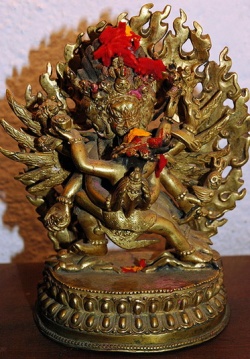The Sakya Tradition - A Brief Overview By Jeff Watt
By Jeff Watt
The History of Sakya begins with a race of celestial beings having descended from the Clear Light heavens in the Realm of Form to take up residence in the snow mountains of Tibet for the benefit of living beings. This was ten generations before the arrival of Guru Padmasambhava in the 8th century.
At this time the hereditary descendents were known as Lha Rig. After eight generations, due to a dispute with a Yaksha leader, the Lha Rig also became known as the Khon which means ‘dispute’ or ‘strife.’ In 750 A.D. the Khon family became students of Guru Rinpoche Padmasambhava receiving the eight Heruka practices, especially the Vajrakila empowerment.
A Khon son, Lui Sungwa, received novice monk ordination from Shantirakshita at Samye Monastery, becoming one of the first seven monk translators in all of Tibet. For the next thirteen generations (750-1073), the Khon family was a central pillar of the Nyingma School in Tsang Province.
In the eleventh century, due to the obscurations of beings, Dharma practice became very lax in the Tsang region. It was decided by the head of the family, Sherab Tsultrim, that it was time to seek out the new Buddhist Tantras from India. Guru Padmasambhava wrote; “an emanation of the Indian Virupa - Drogmi Lotsawa will appear.”
The younger brother, Konchog Gyalpo, went to study with Drogmi Lotsawa (992-1074). At an auspicious location, below a white patch of earth (Tibetan: sa skya), prophesied by Guru Padmasambhava and Lord Atisha, Khon Konchog Gyalpo built the first temple named the Gorum Zimchi Karpo in 1073. This marks the beginning of the name “Sakya.” The holy family, the hereditary leaders of this precious lineage, are known by these three names, Lha Rig, Khon and Sakya.
Sachen Kunga Nyingpo (1092-1158), the son of Khon Konchog Gyalpo, was a person of extraordinary skill and spiritual attainment, holding all the lineages of Sutra and Tantra. His main teachers were first his father from whom he received mainly the Vajrakila and Samputa Systems of practice.
From Bari Lotsawa Rinchen Drag he received Chakrasamvara, Guhyasamaja, Vajrabhairava and others; from Shangton Chobar, the entire Lamdre system (Path together with the Result) over a period of four years along with the systems of Mahamaya and Samayogadakinijala.
From Mal Lotsawa Lodro Drag he received the Chakrasamvara, Bhairava, the teachings of mahasiddha Naropa namely the Vajrayogini, and of significant importance the lineages of Panjarnata Mahakala.
From Lama Nam Kaupa, at Ka’u Drag Dzong, he received all the instructions, outer, inner and secret of the Four-faced Protector Chaturmukha. These were only the principal teachers of Sachen Kunga Nyingpo.
At the age of twelve while in a six month Manjushri retreat he had a vision of Manjushri accompanied by two bodhisattvas who spoke to him with the lines of what has come to be known as the Separation From The Four Attachments; Sachen Kunga Nyingpo received the complete Lamdre teaching first from Shangton Chobar and secondly directly from Virupa in a series of visions that lasted a month.
In the Sakya Tradition it is believed that Virupa came bodily to Sakya to teach Sachen Kunga Nyingpo. This is known as the ‘recent’ or ‘close’ Lamdre lineage.
Sachen had four sons - Kunga Bar, Sonam Tsemo, Jetsun Dragpa Gyaltsen and Palchen Opoche. The first passed away while studying at Nalanda Monastery in India.
The second son Sonam Tsemo (1142-82) became a learned scholar at the early age of sixteen. At the age of forty-one, it is said by some that, he ascended bodily to Khechara, the divine realm of Vajrayogini.
He had visions of many meditational deities and also produced many realized disciples. Jetsun Dragpa Gyaltsen (1147-1216) received lay celibacy vows and showed strong signs of spiritual maturity in his youth. At the age of eleven he gave his first teaching of the Shri Hevajra.
The main student of Jetsun Dragpa Gyaltsen was his nephew, son of Palchen of Opoche the famous Sakya Pandita Kunga Gyaltsen (1182-1251). Studying Buddhist and non-Buddhist philosophy, tantra, logic, Sanskrit, poetry, astrology and art with countless Indian, Nepalese, Kashmiri and Tibetan masters, he achieved mastery over all these subjects.
When twenty-seven years old, after meeting with the Kashmiri Pandita Shakya Shribhadra at Shalu Monastery, he became a fully ordained monk and maintained his vows without the least infraction. His works such as the Treasury of Logic on Valid Cognition (Tsad-ma rigs-gter) and the Discrimination of the Three Vows (sDom-gsum rab-dbye) are famous to this day. In all Sakya Pandita wrote 114 religious treatises.
The Treasury of Logic on Valid Cognition (Tsad-ma rigs-gter) was the only text of Tibetan origin ever to have been translated into the Sanskrit language. The translation was rendered by his Indian students at Nalanda University in Magadha, and was received with much acclaim. “At the time of his mahaparinirvana, the earth shook six times and birds throughout the kingdom cried in lament.
Wondrous signs were seen by the assembly of disciples and kings when the pyre was lit, and all who were present experienced blissful peace. Having attained perfect enlightenment by the grace of Manjunata, he is known to the world as the Buddha Vimalashri.” (Translation by Jared Rhoton).
